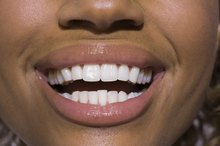Dental Extraction Side Effects
A dental extraction, or tooth extraction, is a procedure in which one or more teeth are surgically removed. Dental extractions may be necessary in cases where a tooth is too damaged from disease or injury to be repaired. Extractions may also be necessary for proper tooth alignment, especially in patients needing braces. Simple extractions, or extractions done on teeth visible in the mouth, are performed by a dentist. Surgical extractions, or extractions done on teeth that have not grown above the gum line or have broken off below the gum line, are performed by oral surgeons. Some side effects may occur with dental extractions.
Jaw Joint Pain
One possible side effect of a tooth extraction is jaw joint pain. Some patients may have difficulty opening their mouth wide, or they may experience pain in the jaw joint while chewing. Jaw joint pain may result from inflammation in the jaw muscles from analgesic injections, from keeping the mouth wide open during the procedure or from pushing or pressure on the jaw during the procedure. In most cases, jaw joint pain subsides on its own.
- One possible side effect of a tooth extraction is jaw joint pain.
- Some patients may have difficulty opening their mouth wide, or they may experience pain in the jaw joint while chewing.
Nerve Damage
Types of False Teeth
Learn More
Some patients may experience long-lasting numbness in the lower lip or chin after a tooth extraction. MayoClinic.com explains that this numbness is likely due to nerve damage done during the tooth extraction. SimpleStepsDental.com adds that nerve damage may take three to six months to heal. In rare cases, numbness may be permanent.
- Some patients may experience long-lasting numbness in the lower lip or chin after a tooth extraction.
- MayoClinic.com explains that this numbness is likely due to nerve damage done during the tooth extraction.
Dry Socket
Dry socket is another possible side effect of a dental extraction. A dry socket occurs when a blood clot either fails to form in the hole or becomes dislodged from the hole left by the tooth extraction. The formation of a blood clot following tooth removal aids in speedier recovery time and less pain. In cases of a dry socket, the absence of the blood causes severe pain in the area of the tooth extraction. Patients may also notice a bad odor or taste in their mouth. A dry socket must be covered with a medical dressing by a dentist in order to heal.
- Dry socket is another possible side effect of a dental extraction.
- The formation of a blood clot following tooth removal aids in speedier recovery time and less pain.
Jaw Fracture
Garlic for a Tooth Infection
Learn More
Jaw fractures are another possible side effect of dental extractions. A jaw fracture may be caused by pressure put on the jaw during an extraction. Fractures are more common in older patients and patients who suffer from osteoporosis, or thinning of bone tissue.
Infection
Infection may occur after a tooth extraction. An infection may be caused by bacteria or trapped food particles getting in the hole left by the extraction. Signs of an infection include fever, increased pain in the mouth or jaw, increased swelling around the extraction site, or draining or bleeding from the extraction site. Infections are treated with antibiotics.
- Infection may occur after a tooth extraction.
Related Articles
References
- SurgeryEncyclopedia.com: Tooth Extraction
- MayoClinic.com: Wisdom Tooth Extraction
- American Association of Endodontists. (n.d.). Cracked Teeth. https://www.aae.org/patients/dental-symptoms/cracked-teeth/
- American Dental Association. (n.d.). Abscess (Toothache). https://www.mouthhealthy.org/en/az-topics/a/abscess
- Hennessy BJ. (2018). Merck Manual Professional Version: Toothache and Infection. https://www.merckmanuals.com/professional/dental-disorders/symptoms-of-dental-and-oral-disorders/toothache-and-infection?query=dental%20abscess
- Schweitzer JL. The Endodontic Diagnostic Puzzle. Gen Dent. 2009;57(6):560-7. https://www.ncbi.nlm.nih.gov/pubmed/19906608
- Ubertalli JT. Merck Manual. Professional Version. (2018). Pulpitis. https://www.merckmanuals.com/professional/dental-disorders/common-dental-disorders/pulpitis?_ga=2.233168734.1798272777.1553437191-365578483.1553437191
- Fukuda KI. Diagnosis and treatment of abnormal dental pain. J Dent Anesth Pain Med. 2016;16(1):1-8. doi:10.17245/jdapm.2016.16.1.1
- Pihlstrom BL, Michalowicz BS, Johnson NW. Periodontal diseases. Lancet. 2005;366(9499):1809-20. doi:10.1016/S0140-6736(05)67728-8
- Heng C. Tooth Decay Is the Most Prevalent Disease. Fed Pract. 2016;33(10):31-33.
- Tonguc MO, Ozat Y, Sert T, Sonmez Y, Kirzioglu FY. Tooth sensitivity in fluorotic teeth. Eur J Dent. 2011;5(3):273-80.
- Yap AU, Chua AP. Sleep bruxism: Current knowledge and contemporary management. J Conserv Dent. 2016;19(5):383-9. doi:10.4103/0972-0707.190007
- Rechenberg DK, Galicia JC, Peters OA. Biological Markers for Pulpal Inflammation: A Systematic Review. PLoS ONE. 2016;11(11):e0167289. doi:10.1371/journal.pone.0167289
- Lubisich EB, Hilton TJ, Ferracane J. Cracked teeth: a review of the literature. J Esthet Restor Dent. 2010;22(3):158-67. doi:10.1111/j.1708-8240.2010.00330.x
- Shweta, Prakash SK. Dental abscess: A microbiological review. Dent Res J (Isfahan). 2013;10(5):585-91.
- Santosh P. Impacted Mandibular Third Molars: Review of Literature and a Proposal of a Combined Clinical and Radiological Classification. Ann Med Health Sci Res. 2015;5(4):229-34. doi:10.4103/2141-9248.160177
- Candamourty R, Venkatachalam S, Babu MR, Kumar GS. Ludwig's Angina - An emergency: A case report with literature review. J Nat Sci Biol Med. 2012;3(2):206-8. doi:10.4103/0976-9668.101932
- Yeo GS, Kim HY, Kwak EJ, Jung YS, Park HS, Jung HD. Cavernous sinus thrombosis caused by a dental infection: a case report. J Korean Assoc Oral Maxillofac Surg. 2014;40(4):195-8. doi:10.5125/jkaoms.2014.40.4.195
- Jacobsen PL, Casagrande AM. Sinusitis as a source of dental pain. Dent Today. 2003;22(9):110-3.
- Murphy MK, Macbarb RF, Wong ME, Athanasiou KA. Temporomandibular disorders: a review of etiology, clinical management, and tissue engineering strategies. Int J Oral Maxillofac Implants. 2013;28(6):e393-414. doi:10.11607/jomi.te20
- Becker DE. Pain management: Part 1: Managing acute and postoperative dental pain. Anesth Prog. 2010;57(2):67-78. doi:10.2344/0003-3006-57.2.67
- Guaita M, Högl B. Current Treatments of Bruxism. Curr Treat Options Neurol. 2016;18(2):10. doi:10.1007/s11940-016-0396-3
- Lee Y. Diagnosis and Prevention Strategies for Dental Caries. J Lifestyle Med. 2013;3(2):107-9.
- Kaptan RF, Haznedaroglu F, Basturk FB, Kayahan MB. Treatment approaches and antibiotic use for emergency dental treatment in Turkey. Ther Clin Risk Manag. 2013;9:443-9. doi:10.2147/TCRM.S52009
- American Association of Endodontists. (n.d.). Cracked Teeth.
- American Dental Association. (n.d.). Abscess (Toothache).
- Chow AW. (2018). Submandibular space infections (Ludwig's angina). In: UpToDate, Calderwood SB (Ed), UpToDate, Waltham, MA.
- Hennessy BJ. (2018). Merck Manual Professional Version: Toothache and Infection.
- Schweitzer JL. The Endodontic Diagnostic Puzzle. Gen Dent. 2009;57(6):560-7.
- Ubertalli JT. Merck Manual. Professional Version. (2018). Pulpitis.
Writer Bio
Cynthia Bateman is a student at Southern Illinois University Edwardsville where she is pursuing her Master of Arts in English with an emphasis in composition pedagogy. She has most recently been published in the literary journal, "River Bluff Review." She is also a registered professional nurse.








